Hot, dry and, at first glance, unsuitable for life, the desert accommodates a huge variety of representatives of the animal world. On our planet, deserts occupy about a third of the land. The surface is covered with sun-baked sand, rubble and stones. It rains very rarely, and there are practically no water reserves. During the day, when the sun is at its zenith, desert animals hide. You can only see a couple of birds and a quickly running lizard. When the heat subsides, the area comes alive.
Dangerous predators
Despite the fact that herbivores predominate in the desert, there is a wide variety of predators. In the struggle for territory and food, they have to constantly hunt and move a lot. They are cunning, dexterous and fast.
jungle cat
A unique desert animal that looks like a pet, but in its temperament is a wild and aggressive predator. Marsh lynx, house and Nile cat are the nicknames that the jungle cat received. Weight is about 15-16 kg, body length up to 1 meter. The body is strong and strong. Powerful paws. The fur is gray-brown with a reddish tint.
This predator goes hunting exclusively in the evening and at night. It can attack either from an ambush or wait for its victim near its hole.
Swims well and rarely climbs trees. It feeds on hares, small rodents and a wide variety of birds. Individuals live alone, well defending their territory. They hide in reeds, thickets, and bushes.
Spotted hyena
Hyenas live in semi-deserts and deserts. These are small wild mammals that eat their prey to the last piece of meat. Widely distributed in Africa. Body length 1.3-1.6 m, weight up to 67 kg. The coat is coarse and short, covered with brown spots. The muzzle is long with powerful jaws that can bite through bones. The tongue is rough, which allows you to remove all the meat from the bones without any residue. The howl that the animal makes resembles laughter.
They feed on both carrion (20% of the total diet) and freshly caught meat. Often they fail during the hunt. Animals are very strong. One hyena can independently kill an antelope, which in its mass is 2-3 times the mass of the predator.
Reference! The den of these animals is untidy and always littered with food debris and bones. At a great distance you can smell a heavy putrid odor both from their home and from the predators themselves.
Tiger
A large and menacing large cat of the desert. It can reach more than 3 meters in length and weigh as much as 310 kg. Southeast Asia is considered the birthplace of these fauna. A hungry tiger is ready to eat everything that comes his way. Hunts mammals and even small animals such as frogs, fish, mice. If a predator has been starving for a long time, it can attack its relative.
The fur is soft and has a unique color: red with black stripes. The tiger is constantly on the move. Lives alone. It marks its territory with a loud and ringing roar. Life expectancy is about 20-22 years.
Puma
This graceful cat is also found in deserts. It can reach up to 1.8 m in length and weigh up to 90-100 kg. Hunts at dawn and at dusk. Ungulates are the favorite prey of predators. They can hide their food in reserve. People are avoided, but there have been cases of attacks in populated areas.
During the breeding season they emit a loud, heartbreaking cry. This is how males attract individuals of the opposite sex. The cubs live with the female until they are two years old. Life expectancy is 20 years.
Gray monitor lizard
In Africa, this animal lives in the northern sandy deserts, as well as in the foothills. For settlement, he uses ready-made burrows of other animals, having previously expanded them. He can run fast, inflate his body and strike the ground with his tail to scare away the enemy.
Conclusion
The desert fauna is more diverse than described above. About 60 species of mammals and more than 300 species of birds are found in the Sahara alone. There you can find a variety of insects and reptiles, jerboas and hamsters, gerbils and antelopes, jackals and mongooses, maned sheep and miniature foxes, dune cats and camels.
Artiodactyl representatives of the desert animal world
This group of animals unites the following orders: proboscis, artiodactyl and equid. The food of these desert inhabitants consists of plants, branches, and fruits. Representatives of ungulates are large and massive. They are constantly on the alert, because they are always the ones being hunted by predators.
Camel
Belongs to the order Artiodactyla. This is a large mammal that is well adapted to hot desert conditions. Probably many people associate camels with deserts. They can weigh up to 800 kg.
There are two-humped and one-humped representatives of this family. The unique organism is designed in such a way as to protect the animal from overheating and night cold. This is helped by fur, large nostrils and humps, in which adipose tissue is stored, decomposing into water at the most necessary moment.
Camels are constantly on the move, despite the fact that they are considered sedentary. They live in small groups of 7-9 individuals. The male has primacy and fiercely defends his harem. At dawn and at dusk they go out to pasture.
Giraffe
This is the tallest animal living on land. The peace-loving desert inhabitant reaches a height of 6 meters and can weigh more than a ton. The giraffe's long neck and 45 cm long tongue allow it to feed on leaves and branches from tall trees. The body is covered with short hair with a unique pattern in the form of spots.
The head has small ears and horns. Large eyes with beautiful eyelashes give the animal a charming appearance. A short mane runs along the entire neck. Herbivores have good eyesight. They can see each other at a distance of 1 km. The legs are high and long. They run at speeds of up to 55 km/h.
Interesting fact! It is surprising that giraffes can jump to a height of 1.8 m, but rivers are an insurmountable barrier for them.
Addax
The large antelope reaches up to 170 cm in length and 90 cm in height. These desert inhabitants weigh about 130 kg. They live in deserts and semi-deserts of northern Africa.
The coat color of the addax can change depending on temperature conditions: in winter it is gray-brown, and in summer it becomes almost white. It wears large horns on its head (up to 75 cm) and has an interesting muzzle color. They feed on plants, branches of trees and shrubs.
The artiodactyl animal, 170 cm long and weighing 65-75 kg, moves well on loose sand. The Addax (Mendes antelope) is well adapted to the harsh climate of the desert. It can go without water for a long time, since it receives the required amount of moisture from plant nutrition. Life expectancy is about 25 years.
Guanaco
The desert fauna surprises with its diversity. A cloven-hoofed mammal called a guanaco can roam under the scorching sun.
The animal belongs to the camelid family, and is also the ancestor of the domesticated llama. Its slender build is often compared to that of a deer or antelope. The long neck serves well as a balancer when running or walking. The head is also long, compressed on both sides. It has protruding ears and beautiful eyes with black eyelashes.
Guanacos run fast. The speed can reach up to 56-57 km/h. It is running that helps them survive. Eating vegetation allows you to go without water for a long time. They are hunted by wolves, dogs and cougars.
Bakers
Amazing desert animals. Outwardly they resemble an ordinary pig. They are classified as non-ruminant artiodactyl mammals.
They are unpretentious to climatic conditions and food, they can eat everything that comes their way: grass, fruits, shoots, cacti, berries, mushrooms, eggs from nests, carrion of frogs and snakes. They weigh up to 25 kg, and grow up to 50 cm at the withers and up to 1 meter in length.
They live in herds of up to 100 individuals. Listed in the Red Book. For a long time they were considered extinct.
Water resources of the Sahara
The main source of the Sahara Desert is the Nile and Niger rivers, as well as Lake Chad. Rivers originated outside the desert and are fed by surface and groundwater. The main tributaries of the Nile are the White and Blue Nile, which merge in the southeastern part of the desert. The Niger flows in the southwest of the Sahara, in the delta of which there are several lakes. In the north there are wadis and streams that form after heavy rainfall and also flow from the mountain ranges. Inside the desert itself there is a network of wadis that was formed in ancient times. It is worth noting that under the sands of the Sahara there is underground water that feeds some reservoirs. They are used for irrigation systems.
River Nile
Amphibians and reptiles
The fauna of the desert is diverse. Many reptiles and even some amphibians have adapted to the dry and hot climate.
Burrowing frog
This is one of the largest frogs in Africa. She can be aggressive and even bite painfully. Lives in semi-deserts. Local residents consider the meat of the burrowing frog to be a delicacy.
The amphibian is a predator. She eats everything that can fit in her mouth. Leads a terrestrial lifestyle. At night it becomes active, and during the day it stays in shallow water.
It has a wide body and a rounded muzzle with a large mouth filled with sharp teeth. The powerful hind limbs are used for digging deep holes. The skin color is bright green with white spots.
Moloch
A unique and very interesting reptile that lives in the desert regions of Australia. Locals call it the thorny devil. Every centimeter of his body is covered with huge spikes.
The devil is associated with his horns on his head and his frightening appearance, which saves him from predators. In fact, the animal is completely harmless. It reaches only 15 cm in length.
The body is wide, the head is small, the paws, although powerful, have short fingers. Body color varies throughout the body. The abdomen is mostly light with a longitudinal pattern.
Horned viper
The Saharan viper has a thick and powerful body and a narrow tail. The body length is 80-82 cm. There are two vertical scales above the eyes, which is why the animal in the desert got its name. On the sides of the body there are smaller scales that form something like a saw.
The color of the horned viper is brownish-yellow with darker spots on the back. Reptiles inhabit the entire Sahara. At night the animals hunt and during the day they bury themselves in the sand.
They feed on rodents, small birds, and lizards. During the breeding season, the female lays about 20 eggs. The young hatch after 48 days.
Varan
This is the largest lizard in the whole world. Its size can be compared to a crocodile. They spend most of their lives in water, so they choose river banks for their habitat. They feed on frogs, birds, snakes, and also attack larger herbivores. To get their food, they have to travel many kilometers. Often they do not even disdain carrion.
Sometimes they themselves can become victims of certain predators (crocodiles, large birds, snakes). To defend themselves, they use their powerful tail and poisonous bites. They are constantly hunted by humans, as their meat, skin and eggs are highly valued.
This is interesting! The largest representative is considered to be the Komodo dragon, whose body reaches a length of 3 meters. The short-tailed monitor lizard is the smallest species. Its length is only 27-28 cm.
Long-eared roundhead
This desert animal has adapted well to the hot climate and hot sand. The length of the round head is 23-25 cm, and the weight is about 38-40 g. During the day, in the heat, it runs quickly among the dunes, while raising its body high and spreading its limbs wide.
Thus, it protects the abdomen from hot sand. If it notices an enemy, it buries itself in the sand with lightning-fast lateral movements, leaving only its head on the surface.
When a predator gets very close, the roundhead opens its mouth wide and straightens the folds of skin at the corners of the mouth (called ears), which quickly become filled with blood. This appearance often frightens the enemy.
Spiketail
A large lizard that can have different colors. Found in the deserts of Algeria and the African Sahara. The massive body is covered with thorny thorns. Lives in rocky and mountainous wastelands.
In hot weather it likes to bask in the sun, and in twilight it is in search of food. The menu mainly includes leaves and fruits. The lizard is always cautious and timid, as it is hunted by many predators.
It reaches a length of 50 cm, a third of the entire length is accounted for by its thick tail equipped with spines. The fingers are short but very strong. The skin is wrinkled, decorated with small spotted patterns.
Beetle Stenocara gracilipes
The insect lives in one of the driest deserts in the world, the Namib in southern Africa. The western regions of the desert are often shrouded in fog, formed from the mixing of the cold Bengal air current with the warmer, humid Atlantic air current. To obtain water, beetles expose their elytra to the humid wind of the ocean. Water droplets condense on them and are then used by insects.
Rodents
Many desert animals are constantly in danger and struggling to survive. Rodents are small representatives of fauna. Their activity increases with the onset of dusk, when the heat subsides. At this time, the search for food begins.
Jerboa
This is a small mammal that belongs to the order of rodents. It adapts perfectly to any climatic conditions, so it also feels good in the hot desert. The length of the animal can reach from 4 to 25 cm. A special feature is its tail, which is 3 times larger than the body length. Searches for food at night and sleeps during the day. The diet includes fruits, grains, roots of bushes and trees, as well as small insects, worms and larvae.
It has developed limbs, thanks to which it runs quickly and escapes from enemies. The muzzle is large, flattened on the sides. The sense of smell is practically absent, but thanks to their long whiskers they find food for themselves.
Interesting fact! All the jerboas were clean. They can brush their fur up to 30 times per day. And the smallest representative fits in a tablespoon.
Spiny mice
An amazing animal that reaches a length (including tail) of only 14 cm. The head is small with large black eyes like buttons and round ears. The rodent's back is covered with light spines, like a hedgehog's.
They are usually gray or pale yellow. White and soft hairs grow on the lower part of the body. Males differ from females in that their fur is longer and forms a kind of mane on their neck.
Spiny mice can shed their skin when in danger. It is not as durable as other mice. Regeneration in rodents occurs quickly and scars do not form at the wound site. They live in Saudi Arabia, Africa, the islands of Crete and Cyprus.
North African gundi
These small animals live in rocky deserts and semi-deserts. Shelter is found in crevices, under rocks. Their ribs are able to flatten, so they are able to crawl into narrow crevices of rocks. They have small and flat ears, as well as large eyes.
The length of their body is 16-23 cm, and the tail is from 1 to 6 cm. The fur, like that of a chinchilla, is soft and fluffy, it perfectly protects animals from cold and heat.
Gundis travel long distances to find food. They feed on plant seeds, grass, leaves, and stems. They live in families. With peculiar cries they notify their relatives of the approaching danger.
Desert hedgehog
The desert or long-eared hedgehog lives in the semi-deserts of Africa. Body length 13-27 cm, weight up to 500 g. The needles on the back are thin and short. The muzzle is covered with light hair, the eyes are small and black, and the ears are quite large. This small desert animal comes out to hunt after dark.
Eats locusts, centipedes, spiders, scorpions. Thanks to its strong jaws, it deftly grabs its prey and pulls it out from under the soil.
Cape ground squirrel
The animal lives in the arid regions of South Africa, settling in shallow burrows. Outwardly, it slightly resembles ordinary squirrels, but does not live in trees. The body length of this desert rodent is about 22-26 cm. It has a tail of the same length. The animal's diet includes seeds and fruits, edible rhizomes and bulbs of various plants, insects, and small lizards.
Birds
Desert animals also include a wide variety of birds. Each representative has a different way of eating and external features.
African ostrich
It is a ratite bird, unable to fly. It has a huge weight, up to 150 kg. The feathers are underdeveloped, which will also never allow them to rise into the air. The ostrich reaches a height of 2.7 meters. The head is small and flattened, the neck is long and thin. The beak is flat and straight.
Large eyes are decorated with thick eyelashes. The limbs are powerful and long, which allows them to move quickly on land (running speed can reach up to 70 km/h).
Griffon Vulture
The bird got its name due to the fact that its entire body is covered with brown plumage, and only its head is painted white by nature. This is a large flying predator that attacks small rodents, insects, and worms. Weighs up to 15 kg, body length is 1 m, its wingspan is 3 meters. The head is covered with fluff, but the body is covered with large feathers of varying lengths.
Desert Raven
Brown-headed is its second name. Brown feathers are located on the head, neck and back. The length of this bird is about 55 cm, weight 500 g. It is found in the African Sahara and the deserts of Sudan. Not only males, but also females build their nests. The dwelling is used for 3-4 years.
Many people are interested in the question of what animals in the desert can survive in such a hot and dry climate, where there is practically no precipitation. In fact, the fauna, even in such a sandy area, is diverse and unique.
Interesting facts about the Sahara
Among the interesting facts about the Sahara, it should be noted that it is not completely deserted. More than 500 species of flora and several hundred species of fauna are found here. The diversity of flora and fauna forms a special ecosystem on the planet.
In the bowels of the earth, beneath the sandy seas of the desert, there are springs of artesian water. One of the interesting phenomena is that the territory of the Sahara is changing all the time. Satellite images show that the desert area is either increasing or decreasing. If the Sahara was previously a savannah, now it is a desert, it is very interesting what several thousand years will do to it and what this ecosystem will turn into.
Dressing
Or, as it is also called, the pereguzna hunts mainly gophers, but can also feast on a mouse or jerboa. When meeting an enemy, she can take a threatening pose, throwing her tail behind her back and growling, but if this does not scare him, the predator will move on to more effective actions - like a skunk, she will release the secretion of the anal glands, which has an extremely unpleasant odor.
Dune cat
This predator prefers the most inaccessible desert and mountainous places and leads such a secretive lifestyle that scientists know little about it. It is smaller than its domestic relatives, and the soles of its paws are completely covered with thick hair, so as not to get burned when moving on hot sand.











